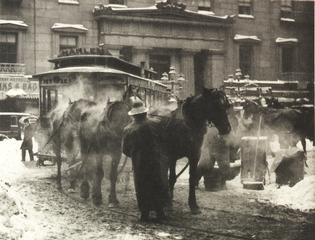I’m fascinated by the artists and arts professionals who were there at those key turning points in history to define the new directions for art.
One who had profound influence on defining art in America was Alfred Steiglitz. Like Theo Van Gogh before him, this giant of a man and his influence on art and artists earlier this century remains essentially unknown to many. Artist and Arts professional in one being, he nurtured the talents of many young artists to create the new American art of this century.

Alfred Steiglitz: The Terminal, 1892
I recently came across a really excellent documentary of Steiglitz’s life and work: “Alfred Steiglitz – The Eloquent Eye”. I strongly recommend that you see it to learn more about this great man, his strengths, achievements, and all his human challenges too.
Here is a review of the documentary by Nicholas Croft:
This 90 minute American Masters documentary chronicles the journey of photographer Alfred Stieglitz, whose life closely parallels the birth of the Modernist Art movement within American culture. The story begins in late 1880’s Berlin, with Stieglitz ending his studies as a mechanical engineering student to take up intensive self study in the then new medium of photography. With an allowance from his supportive father, he traveled to Austria and Italy making many early photographs.
In 1893, we find Stieglitz in New York City, where he begins his struggle to help make the practice of photography become recognized as a serious form of artistic expression. By 1902, along with a group of accomplished photographers, he formed an organization called the Photo Secession. Their highly coveted publication, “Camera Work”, was propagated throughout the city by word of mouth.
From 1902 to 1907, Stieglitz championed the work of other photographers, rather than his own work, in a new gallery at 291 5th avenue. Gradually, the gallery shows began to include works of new painters from Europe, in addition to those first works of the New York photographers. An early exhibit of the work of Picasso at “291” in 1911, was Picasso’s first one-man show in the United States.
With the American involvement in World War I during 1917, Gallery 291 closed and the publication of “Camera Work” ceased. Stieglitz’s correspondence with painter Georgia O’Keeffe helped to sustain him through these emotionally difficult years of social isolation. In 1922, O’Keefe and Stieglitz were married. Stieglitz made approximately 300 intimate portraits of O’Keeffe around this time, creating one of the first deeply devotional photographic portrait series ever attempted.
With the advent of the great depression, Stieglitz’s anarchist sensibilities began to clash with the collectivist mood of the time. This led to a body of profoundly elegiac portraits of New York City, completed during the later years of his life. In 1937, Stieglitz laid down his camera, abandoning further photography. He died during the year 1946.
This documentary details the work of an astonishing range of visual artists and writers whose lives were intertwined with the life of Alfred Stieglitz. It allows each artist to “speak the truth as they see it” and will make a welcome addition to any comprehensive study on the history of modern art.
You can pick this DVD up from Amazon or rent it from Netflix if you are a member. It really is worth seeing to understand more about how today’s art world came to be.
Technorati Tags: art, art collectors, art marketing, art resources, art sales, artist websites, selling art, spiritual art
